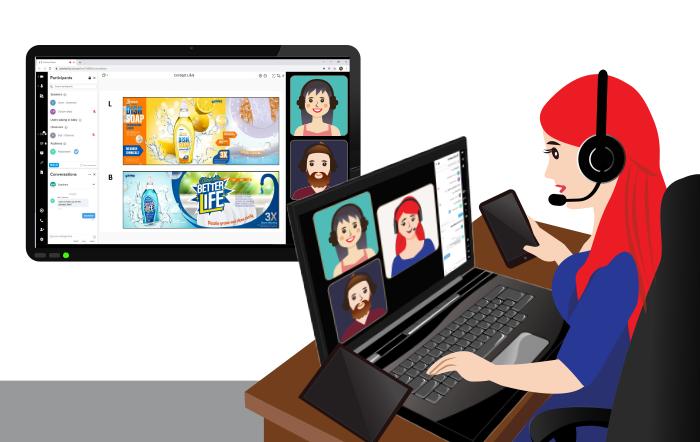It’s no secret that one of the most valuable commodities in the world today is data. In fact, companies place a high value on it to determine their next steps. According to this article, eight out of ten organizations view data as one of the most valuable assets.
Every day, an astronomical amount of information is generated both offline and online that can offer plenty of benefits to businesses of every size. But with the large volume of data available right now, the type of information that companies need to make justified decisions comes at a price.
Large organizations usually hire an external market research firm or have dedicated teams that conduct their studies for them. But what about smaller brands that lack the resources to employ these services? This is where do-it-yourself or DIY research comes in. As people embrace the efficiency and convenience of technology, virtual DIY platforms are continuously gaining traction amongst researchers that lack the budget or bandwidth for a full-fledged project team.
This in-depth guide will explore various aspects of DIY research and uncover how it can serve as a valuable instrument in an independent researcher’s pursuit of actionable insights.
What is Do-It-Yourself Market Research?
.png?width=700&name=2_What-is-Do-It-Yourself-Market-Research%20(1).png)
As the words “do it yourself” suggest, DIY market research is a term used to describe a researcher who directs, customizes, and coordinates their own qualitative study from start to finish. It involves leveraging an arsenal of tools that are tailored to their needs so that they can distinguish the signal from the noise.
In an era where the consumer is king and information is abundant, it’s essential to conduct market research to pinpoint what your customers need and desire from your business. DIY lets you do exactly that. It helps budget-conscious researchers gather a great deal of insight in a shorter amount of time.
Who are DIY researchers?
Three things characterize a DIY researcher: They are experienced, resourceful, and innovative.
What they lack in budget and bandwidth, they make up for in skills and knowledge. According to this AMA survey, independent researchers typically have 4 to 10 years of experience in market research, either from undergraduate courses or on-the-job training. This level of knowledge, coupled with the right tools, can lead them to discover self-directed research opportunities that align with their timeline and budget.
Traditionally, clients hired external market research firms to do their studies. Still, with the emergence of digital marketing, DIY research platforms began making a name for themselves as inexpensive solutions that provide faster turnaround times for deliverables. This resulted in the larger and more well-established firms no longer being the majority of those conducting market research projects. Through a DIY approach, general marketers and non-experts could facilitate their own projects as they familiarize themselves with the various self-serve platforms out on the market.
The role of technology in DIY research
As more people embrace technology, the options for DIY begin to pile up. There has been a significant acceleration in technology’s role in optimizing the research process, enabling you to leverage various digital tools and services to drive your research results faster.
Digital qualitative solutions continue to impact the industry. The growth of new technologies, especially cloud-based software, allows for easy access to digital solutions that assist in capturing, analyzing, and organizing data. Traditional market researchers should not be afraid of this shift and should take an active role in adapting to more agile market research techniques – these platforms can improve quality, productivity, and speed.
The Advantages of DIY Research

Affordability
One of the biggest pros of DIY is that it’s an ideal option for conducting cost-effective market research instead of hiring an external firm. These low-cost market research platforms can provide agile and robust insights when utilized correctly, generating similar results to what you would expect from a full-service MR firm.
If you’re conducting numerous studies, self-directed research creates more long-term value for the researcher in terms of the time and money saved. There are also digital platforms available nowadays that bundle multiple DIY market research tools at a reasonable price, providing a complete research experience.
Accessibility
The newest independent research solutions are developed with accessibility and intuitiveness in mind. This means that they don’t require considerable skill to navigate, and you don’t have to employ other services to finish your project.
Usually, a simple onboarding process is all that’s needed to familiarize yourself with the platform before being left to handle your qualitative research on your own.
Efficiency
When working with a traditional research firm, there is usually a lag between the interviews and the findings generated. Waiting for results could take weeks or even months, which could be detrimental when important decisions need to be made on short notice.
With you being solely responsible for your project, you have complete control over your timelines and when you receive your data. Actionable insights can be gathered in a few hours or days, enabling you to support decisions in real-time.
Customization
Utilizing DIY research platforms allows you the freedom to experiment with different tools based on your research objectives. At times, you may require a web room or use a mobile app to collect data. Sometimes you may also want to bookmark, make clips or create storyboards from your video recordings.
DIY Tools for Market Research

Surveys
Surveys are a widely used market research method for gathering a high volume of data. It consists of distributing mobile or online surveys that contain open-ended or close-ended questions for respondents to answer.
If you’re carrying out your own market research, this technique is ideal for collecting information from a larger sample. It can also be used to recruit participants for a quant/qual study or to obtain statistical data for analysis.
Web Rooms
Moderating interviews and focus groups are essential for gathering extensive information about a research topic and understanding the ‘Why’ behind the ‘What.’ But these methods don’t have to be confined to a research facility. With the help of a trusted online service provider, independent researchers can facilitate sessions remotely using their webcams.
Web rooms can be easily accessed because they are web-enabled. Respondents can join in the discussion by simply clicking a meeting link on their browser and logging in from their location. This hugely benefits DIY researchers because their participants are not required to live within a specific geographical area or travel to the research facility.
These secure web rooms also integrate valuable features like screen sharing, stimuli upload, video recording, client live stream, private chat, and crystal clear audio. They leverage technology to provide a convenient alternative for in-person interviews and focus groups.
Mobile Ethnography
You would be hard-pressed to find someone that doesn’t own a mobile device nowadays. In 2022, the number of smartphone users totaled over 6.6 billion people, or eighty-three percent of the world’s population. Smartphones provide users with the means to efficiently communicate and complete tasks on the go, making them a vital part of daily life.
This need for instantaneous communication and connectivity prompted the development of mobile apps that collect real-time data. In DIY research, ethnography apps enable respondents to use their phones to complete research tasks on the go, making them useful for screening, homework assignments, or asynchronous studies.
Media Curation
A curation tool is essential for storing and managing the findings you generate from various data streams. Compile and analyze videos, photos, and audio through features such as clipping, bookmarking, highlight-reel creation, and automated transcripts.
For DIY research, having a secure platform to condense deliverables is important in creating compelling and informative DIY market research reports.
DIY Best Practices

Familiarization
No matter how intuitive a DIY research platform may be, there will always be a learning curve before you can consider yourself proficient in operating it. A certain level of training is required to feel comfortable using the tools and functions that make up a self-serve platform.
Specific DIY solutions offer an onboarding process to prevent project mishaps that may stem from platform misuse. This process aims to assist you in learning about the ins and outs of each tool included in the platform and how you can navigate them to foster a seamless research experience.
Assessment
The value of a platform depends on the extent to which it can accommodate the researcher’s needs. The tools you choose should match your process and the type of data you wish to acquire.
Whether you need a tool for surveying, online qual, or visualization, it’s important to evaluate what capabilities are being offered in a DIY platform to better plan your holistic approach as it relates to your research objectives.
Connectivity
According to a recent ESOMAR study, clients in the US use about 5.4 tools per company, with smaller teams using an average of 3.5 tools and larger, 100-person teams using 6.1 types of tools and approaches. While leveraging individual systems can still provide you with the data needed, you should keep in mind that going with a fragmented approach can negatively impact the usage of your time and resources in the long run.
Today, there are DIY packages available online that bundle different tools to optimize your study without the hassle of multiple fees and onboarding sessions.
Preparation
Before implementing an effective DIY project, it’s vital to assess different DIY research platforms in order to find the one that is best suited for your objectives and the type of data you wish to seek. Do you seek to improve brand awareness? Measure market effectiveness? Or maybe test a concept? After pinpointing your project goals, formulate a research design that revolves around gathering insights that can help improve brand strategy and customer engagement.
The Role of DIY Research in Business
.png?width=700&name=6_The-Role-of-DIY-Research-in-Business%20(1).png)
Concept Testing
Tapping into consumer sentiment should always be the first step before making big decisions, such as releasing a new product or service. Before anything goes into the development cycle, you want to collect frequent feedback from customers to gauge their thoughts and feelings about certain concept ideas. Afterward, products can be adapted to match their needs.
This can be done through facilitating your own in-depth interviews and focus groups or an ethnographic study wherein you can observe how customers behave when they’re shopping or using similar products.
DIY market research helps refine ideas as well as maximize chances of identifying product lines that could become a hit with the target audience.
Consumer Behavior
Today’s consumers want their opinions to be heard more than ever before. They are much more in control of their purchase decisions and know that they can dictate the type of shopping experience that they want.
The challenge for the DIY researcher is how you can get into the minds of consumers so that you can empower them to engage with the business. With new trends popping up day by day, it could be hard to keep up with the market’s ever-changing needs.
Using a do-it-yourself market research platform helps you capture the consumer’s voice and understand their motivations behind why they buy or avoid certain products. These platforms enable you to remain forward-looking on consumer trends while getting agile results cost-effectively.
Competitor Analysis
The famous author Sun Tzu once wrote,” If you know your enemies and you know yourself, you will not be at risk in a hundred battles.” In business, this line indeed resonates when collecting intelligence on competitors.
One of the reasons that data has become vital in doing business is because it diminishes the likelihood of surprises and keeps a company three steps ahead of everyone else. The game-changing nature of a competitive analysis is that it enables brands to leverage what they’ve learned about themselves and their rivals to establish benchmarks, identify and fill gaps in their business, as well as improve their strategies.
DIY market research tools can help independent researchers optimize this process by helping you gather, translate, and compile your findings into targeted actions and business outcomes that will benefit your clients and give them an edge over their competitors.
Brand Research
When venturing into a foreign market, one of the first obstacles businesses may encounter is how consumers from that market view a brand. The big question is, how can they adapt and promote their products or service according to consumer needs? To answer this, they have to ask potential customers from the market they wish to enter.
This can be done by conducting a DIY study to assess specific business aspects such as overall awareness, customer perceptions, potential competitors, and performance. Gathering qualitative data on these facets allows businesses to gain valuable information about their brand health and market potential.
Adapting a DIY qualitative approach empowers researchers to design, facilitate and analyze their results efficiently without a full-service firm. In addition to that, companies can tap into more markets more frequently for a lower cost than hiring an external market research firm.
Market Sizing
Every business ever created has always started with a unique or innovative idea. However, the success or failure of a business is not only dependent on an original idea but on whether people want to buy the product or not. Market sizing should be conducted to determine whether a business idea is profitable and worthwhile.
Market sizing is a critical step for any new business or product initiative. Its value lies in its ability to estimate the validity of ideas and the size of the market, providing a reliable way of getting representative validation of business potential. DIY research can help brands validate their ideas in real-time, providing unique market knowledge that no one else has access to.
Finding the Right DIY Platform
Convenience
It’s time to eliminate the stigma that self-directed research cannot produce fast, high-quality results economically. If you’re on a tight budget or schedule, go for a DIY platform that bundles all your necessary tools and is easy to use. Using these platforms allows you to access robust data in real-time without worrying about deadlines or paying heavy costs.
Capability
The platform you select should be designed with you, the independent researcher, in mind. Think of your objectives, how you can meet them, and what type of tools you need for a fruitful research experience. As much as possible, the platform should possess the capability to support your project from start to finish without the need for using other tools. For example, you could use a platform that bundles an ethnography app for pre-interviews, web rooms for diving deeper into respondent answers, and a curation tool for organizing and clipping media, creating transcriptions, and analysis.
Security
Having complete ownership over your study also means that you have to carry the responsibility of protecting the security and confidentiality of your data. Ensure that the platform you choose is GDPR & HIPAA compliant so that the data you gather is encrypted – enabling your findings to be stored securely. The ideal platform should also allow your colleagues and clients to access the data from the same platform, thus avoiding the transfer of data to a potentially unsecured environment.
Support
When searching for a self-directed platform, it is important to note whether the service offers an onboarding process to help you familiarize yourself with the tools included. An onboarding process enables you to operate each tool to its full potential and facilitate a more efficient research project.
Although a platform is DIY-centered, it doesn’t have to mean that you should have to fend for yourself if you have any technical problems. Look for a service that can provide you with a tech team that is available to answer questions when you need assistance.

Execute Your DIY Research With Confidence Using Civicom MyQual™
This accessible, affordable, and secure online Do-It-Yourself solution provides independent researchers with the toolset needed to facilitate qualitative research from start to finish. Gather robust insights with capabilities such as webcam streaming, media curation, and mobile homework using this robust DIY research package. Learn more about MyQual™ and the tools it can offer to ensure a positive research experience.



